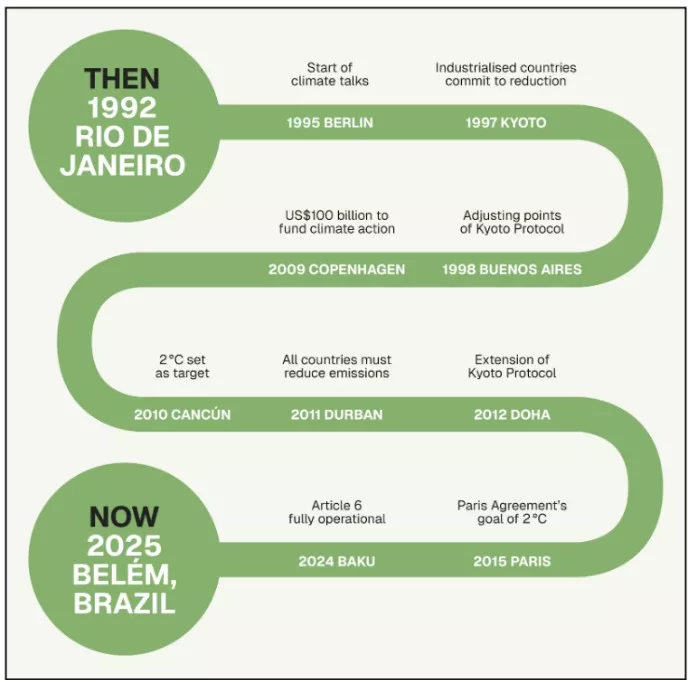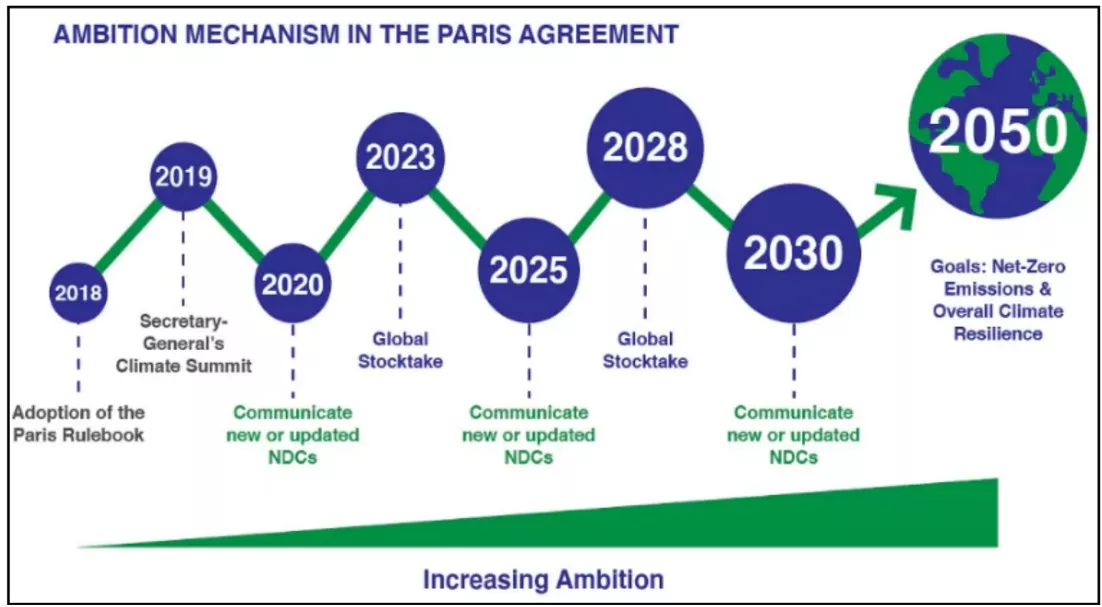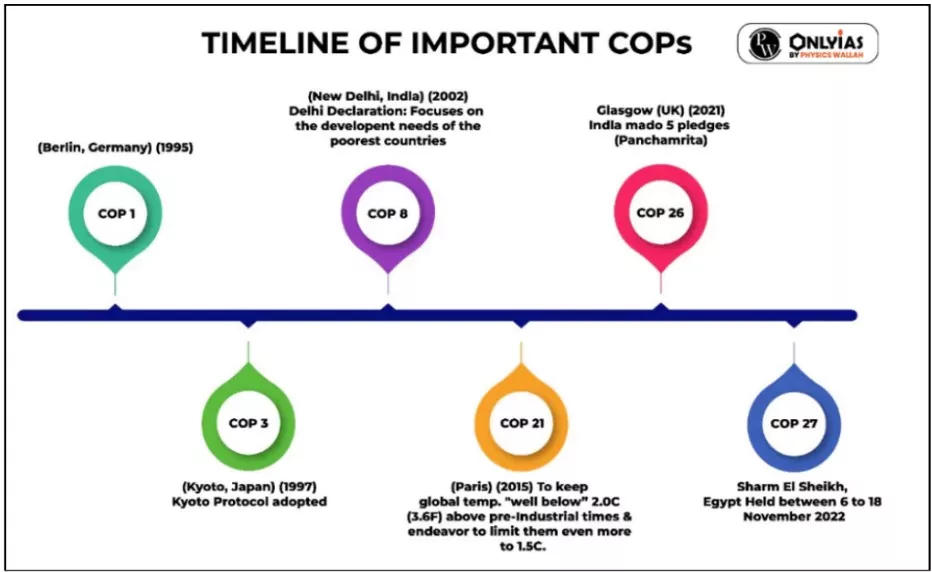![]() 30 Oct 2025
30 Oct 2025

Ten years after the 2015 Paris Agreement, carbon emissions and climate disasters still rise, yet it has sparked a global move toward clean energy, showing that joint global efforts can change climate outcomes.
 It placed binding emission reduction obligations on developed nations, while developing countries contributed voluntarily based on their capabilities.
It placed binding emission reduction obligations on developed nations, while developing countries contributed voluntarily based on their capabilities.
| COP & Year | Venue | Key Outcomes and Achievements |
| COP21 (2015) | Paris, France | Adoption of the legally binding Paris Agreement by 195 Parties; global temperature goal set to well below 2°C with efforts to limit to 1.5°C; introduction of Nationally Determined Contributions (NDCs); establishment of a five-year cycle to raise ambition; recognition of equity and Common but Differentiated Responsibilities (CBDR). |
| COP22 (2016) | Marrakech, Morocco | Initiation of the Marrakech Partnership for Global Climate Action linking governments, businesses, and civil society; agreement on timelines to develop the Paris Rulebook for implementation. |
| COP23 (2017) | Bonn, Germany (Presided by Fiji) | Launch of the Fiji Momentum for Implementation; emphasis on adaptation and resilience for small island developing states; progress on Loss and Damage and climate finance. |
| COP24 (2018) | Katowice, Poland | Adoption of the Katowice Climate Rulebook outlining operational guidelines for implementing the Paris Agreement; finalisation of rules for NDCs, transparency, and the Global Stocktake; inclusion of a just transition framework for workers. |
| COP25 (2019) | Madrid, Spain | Reaffirmation of global commitment to the Paris goals; limited progress on carbon markets (Article 6); recognition of the oceans–climate nexus as a critical area of action. |
| COP26 (2021) | Glasgow, United Kingdom | Adoption of the Glasgow Climate Pact; first global call to phase down unabated coal and end fossil-fuel subsidies; reaffirmation of the 1.5°C goal; announcement of India’s Net Zero by 2070 and Panchamrit strategy. |
| COP27 (2022) | Sharm El-Sheikh, Egypt | Establishment of the Loss and Damage Fund for vulnerable nations; recognition of just transition pathways; decision to revisit and strengthen NDCs by 2023 to align with the 1.5°C goal. |
| COP28 (2023) | Dubai, United Arab Emirates | Completion of the first Global Stocktake (GST); recognition of the need to transition away from fossil fuels; operationalisation of the Loss and Damage Fund with over $700 million pledged. |
| COP29 (2024) | Baku, Azerbaijan | Agreement on the New Collective Quantified Goal (NCQG) to replace the $100 billion annual finance target post-2025; focus on enhanced adaptation funding and technology transfer mechanisms. |
| COP30 (2025) | Belém, Brazil | Marking 10 years of the Paris Agreement; review of first GST outcomes; reaffirmation of multilateralism; emphasis on five global priorities—emission reduction, just transition, protection of natural sinks, empowerment of non-state actors, and defense of climate science. |
 Equity and Differentiation: It operationalises Common but Differentiated Responsibilities (CBDR), allowing flexibility for national contexts while ensuring global accountability.
Equity and Differentiation: It operationalises Common but Differentiated Responsibilities (CBDR), allowing flexibility for national contexts while ensuring global accountability.| Dimension | Developed Countries | Developing Countries | Least-Developed Countries (LDCs) |
| Responsibility and Historical Context | View the Paris model as a shift from the Kyoto Protocol’s binding obligations to a flexible, universal framework involving all nations. | Emphasise Common but Differentiated Responsibilities (CBDR), arguing that developed nations must still bear the primary burden due to past emissions. | Highlight historical injustice, noting they contributed the least but face the worst climate impacts. |
| Core Priorities | Focus on technological innovation, carbon markets, and green competitiveness to sustain economic leadership. | Aim to balance development with climate goals, prioritising energy access, poverty reduction, and sustainable growth. | Concentrate on adaptation and resilience, as survival is their foremost concern. |
| Nationally Determined Contributions (NDCs) | Treat NDCs as voluntary, self-determined commitments; resist external monitoring. | Submit conditional NDCs linked to finance and technology access; seek flexibility to suit domestic needs. | Have basic or support-dependent NDCs, requiring external capacity-building and finance to implement. |
| Climate Finance and Equity | Deliver limited funding; the $100 billion pledge remains underfulfilled; the Baku 2025 deal ($300B from 2035) reflects modest ambition. | Demand predictable, concessional finance and technology transfer; highlight that trillions are needed annually for mitigation and adaptation. | Seek grant-based finance for adaptation and Loss & Damage compensation as a matter of justice, not aid. |
| Technology and Capacity-Building | Prioritise intellectual property and commercial innovation models; prefer market-driven partnerships. | Advocate open-source technology transfer under UN mechanisms and collaborative R&D. | Require affordable, ready-to-use solutions with training and long-term maintenance support. |
| Trust, Justice, and Multilateralism | See Paris as inclusive but often fail to meet promises, fuelling scepticism. | Express growing distrust over unfulfilled pledges and dilution of CBDR principles. | Feel excluded and disillusioned, turning to legal forums like the ICJ (Vanuatu 2024) for accountability. |
| Expectations for COP30 and Beyond | Push for rule-based transparency and expansion of global carbon markets. | Seek stronger climate finance mechanisms, equitable representation, and just transition frameworks. | Demand legally enforceable finance commitments, rapid disbursement, and recognition of climate reparations. |
Check Out UPSC CSE Books
Visit PW Store
About Recent COP Developments
Key Priorities for COP30 and Beyond
|
|---|
The Paris Agreement remains humanity’s strongest collective effort to fight climate change. Though challenges persist, the low-carbon transition is irreversible, powered by innovation, solidarity, and global climate consciousness.

<div class="new-fform">
</div>